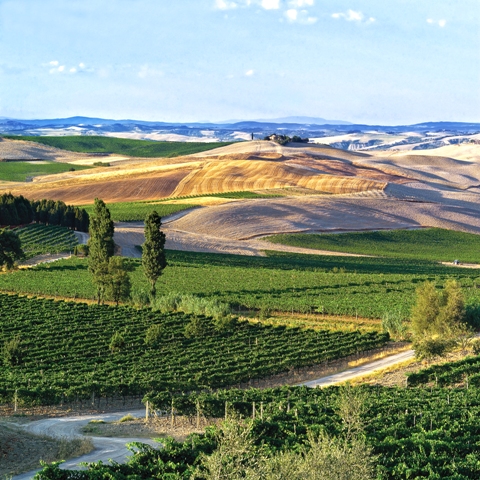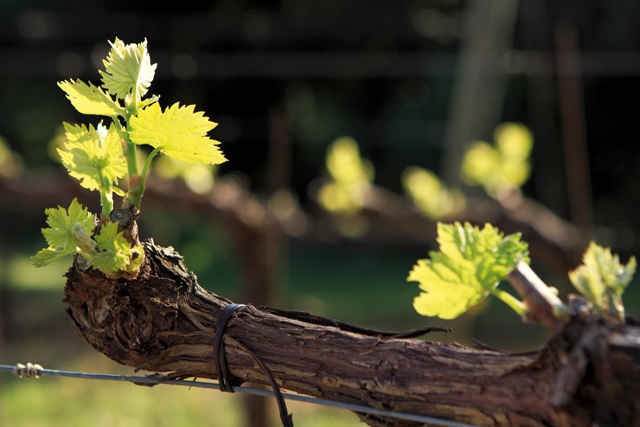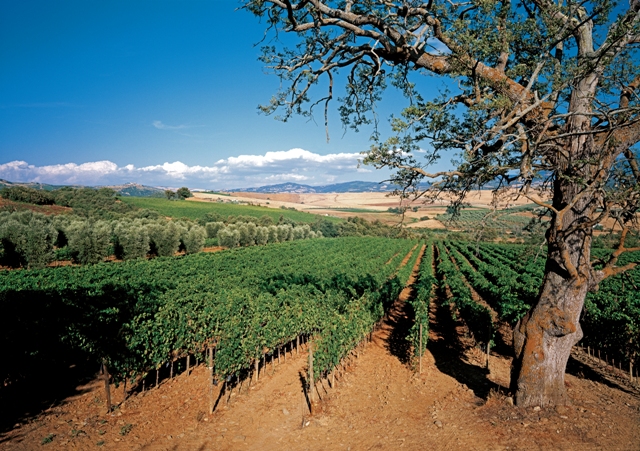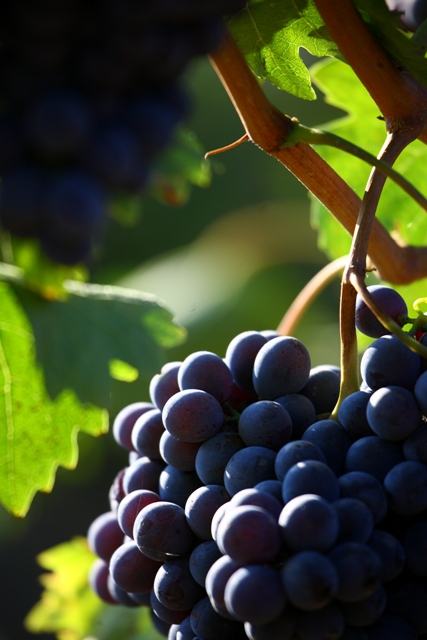 Whether because of its geographical situation, far from busy highways or whether because of the pure air that pervades a wild unspoilt panorama, the territory of Montalcino recalls the magic bond between man and nature that, here, has the rare quality of being totally spontaneous. The township of Montalcino (564 metres above sea level) is 40 kilometres south of Siena. The territory is bounded by the valleys of the Orcia, the Asso and the Ombrone rivers and has a surface of 24,000 hectares. The prevailing economy is agricultural and covers a small part of the surface divided as follows: 50% covered with woods and fallow land; 10% with olive groves; 15% with vineyards, the remainder is arable land, pasture and other cultivations.
Whether because of its geographical situation, far from busy highways or whether because of the pure air that pervades a wild unspoilt panorama, the territory of Montalcino recalls the magic bond between man and nature that, here, has the rare quality of being totally spontaneous. The township of Montalcino (564 metres above sea level) is 40 kilometres south of Siena. The territory is bounded by the valleys of the Orcia, the Asso and the Ombrone rivers and has a surface of 24,000 hectares. The prevailing economy is agricultural and covers a small part of the surface divided as follows: 50% covered with woods and fallow land; 10% with olive groves; 15% with vineyards, the remainder is arable land, pasture and other cultivations.
The climate is typically Mediterranean, with rainfalls concentrated during the spring and autumn months. In winter, above 400 metres, snowfalls are not rare. The medium hilly area (in which most of the vineyards and wine making estates are concentrated) does not get mists or ice or late frosts that can hit the valleys, while the presence of wind guarantees healthier conditions for the plants.
The long ageing of Brunello
 Brunello is obtained exclusively from Sangiovese grapes (locally known as “Brunello” grapes) grown within the territory of the Montalcino township. The name “Brunello” can be applied only to the wine produced and bottled within the township of Montalcino. The production of Brunello, especially since the eighties, has undergone a clear widespread evolution in quality, followed by constantly growing world fame.
Brunello is obtained exclusively from Sangiovese grapes (locally known as “Brunello” grapes) grown within the territory of the Montalcino township. The name “Brunello” can be applied only to the wine produced and bottled within the township of Montalcino. The production of Brunello, especially since the eighties, has undergone a clear widespread evolution in quality, followed by constantly growing world fame.
Brunello was one of the first wines to obtain the Denomination of Controlled Origin (DOC) in 1966 and the first Italian wine to have obtained the Denomination of Controlled and Guaranteed Origin (DOCG) in 1980.
The main feature of Brunello is its long ageing before being put on the market that determines its characteristic brilliant transparent ruby red colour, tending towards garnet. Naturally it must be kept in the right conditions: in a cool cellar, but above all with a constant temperature, in the dark without noises or smells, in bottles laid horizontally. Its alcohol content is 12.5° (minimum), and often higher, easily reaching 13.5°; its total acidity (minimum) is 5 gram/litre and its minimum dry extract is 24 grams/litre. Brunello is only bottled in Bordelaise shaped bottles with a capacity in litres of 0.375; 0.500; 1.5; 3.0; 5.0.
Its perfumes are mostly intense and greatly persistent and complex recalling scents of undergrowth, red berries, earth, as well as the sweet spicy aromas that come from wood and ageing. To the palate, Brunello is both elegant and harmonious, with a rich well-balanced structure and considerable acidic freshness.
The elegance and harmony of its body allow for this wine to be accompanied by very structured and composite dishes such as red meats; it also goes extremely well with dishes of international cuisine based of meats and sauces. Brunello is also an excellent accompanying wine for cheeses: seasoned tomes, Tuscan pecorino, structured cheeses. It is also a wine for meditating.
Brunello di Montalcino must be served in widely shaped crystal glasses, in order to capture its harmonious bouquet. It should be served at a temperature of 18ºC-20º. For the more aged bottles it is advisable to decant the wine in crystal carafes so as to oxygenate it.
The numbers of success
The Consortium - created in 1967 right after the recognition of the DOC, as a free association of producers, intent on safeguarding their wine – safeguards, controls and promotes all four denomination wines of Montalcino: Brunello di Montalcino, Rosso di Montalcino, Moscadello di Montalcino, and Sant’Antimo. 100% of the producers (250 producers of whom 208 are bottlers), a unique case in the whole of Italy, are registered with the Consortium. The hectares of vineyards in the Montalcino territory amount to 3500 divided as follows: 2100 hectares grown with Brunello di Montalcino; 510 hectares with Rosso di Montalcino; 50 hectares with Moscadello di Montalcino; 480 hectares with Sant’Antimo Doc; the remainder is planted with IGT.
On average every year 9,000,000 bottles of Brunello di Montalcino are produced; 4,500,000 of Rosso di Montalcino, 40,000 of Moscadello di Montalcino and 400,000 of Sant’Antimo. Around 65% of the production is exported and the total value of the average turnover of the wine sector in Montalcino is 160 million euros.
Not only Brunello
Montalcino is not just limited to Brunello: for the first time in Italy, the producers of this area were accorded the possibility of obtaining, from the same vineyards, two denomination of origin wines base on precise evaluation techniques: Brunello, destined for long ageing, and Rosso di Montalcino, a younger wine that combines a superb structure with attributes of particular liveliness and freshness.
Rosso di Montalcino
Rosso di Montalcino is harmonious, elegant, tasty. Its aspect is brilliant and limpid, with a composite ruby colour: it has a good smell intense and fragrant, with recognizable hints of fresh fruit; it has strength and freshness with a good persistent aroma. It is not to be kept too long, preferably it should be drunk at a young age even though it ages well.
Its characteristics are exalted by typical Tuscan cuisine dishes with a straightforward decisive taste but it can just as well be accompanied, enhancing them, by various international dishes. It goes well with medium structure dishes, such as entrées of pasta with meat, chicken mushrooms or truffles sauces or composite risottos, and main dishes prepared with pork meats or veal with sauce.
It can only be sold if it is bottled in bordelaise type bottles and it should be served in red wine crystal glasses at a temperature of around 18ºC.
Moscadello di Montalcino
Moscadello di Montalcino is a dessert wine produced in the still, sparkling and late harvest types. The Sparkling Moscadello is light straw yellow; the Still one tends to be a duller yellow and the Late Harvest has a golden yellow colour. The aroma is of fresh well-balanced Muscat, with flowery hints. The palate is sated by the sweet aromatic harmony of the still type, while the sparkling also offers the inviting zing of a light perlage. The late harvest type boasts a velvety enveloping elegance of a raisin wine.
Moscadello di Montalcino still and sparkling should both be drunk when they are still young, while the late harvest type is at its best after a few years. Its best moment is at the end of a meal, as a pleasant accompaniment to pastry and biscuits.
Sant’Antimo
Sant’Antimo takes its name from the famous medieval abbey situated a few kilometers from Montalcino, that, according to legend, was founded by Charlemagne. It is the latest Doc to have been obtained in Montalcino (1996), born of the desire of the producers to qualify all the wine production of the entire territory: currently 100% of Montalcino’s vineyards are denomination of origin, following the concept of ‘total quality’. Sant’Antimo is a very ample denomination that provides for many typologies of both red and white wines. There is for example Sant’Antimo Rosso that can be made of varieties such as Cabernet, Merlot or Pinot Nero, or even Sant’Antimo Bianco that can be made with varieties such as Chardonnay, Sauvignon and Pinot Grigio. The Rosso type can also be produced with Novello. It is also possible to produce Sant’Antimo Vin Santo with white grapes and Sant’Antimo Vin Santo Occhio di Pernice with red grapes, both with the typology Riserva. The range of combinations and accompaniments is very wide, since the wines of each single typology can be tasted at their best with so many different cuisines either local or Italian, international or of creative fantasy; from appetizers and hors d’oeuvres to all the most varying dishes.
